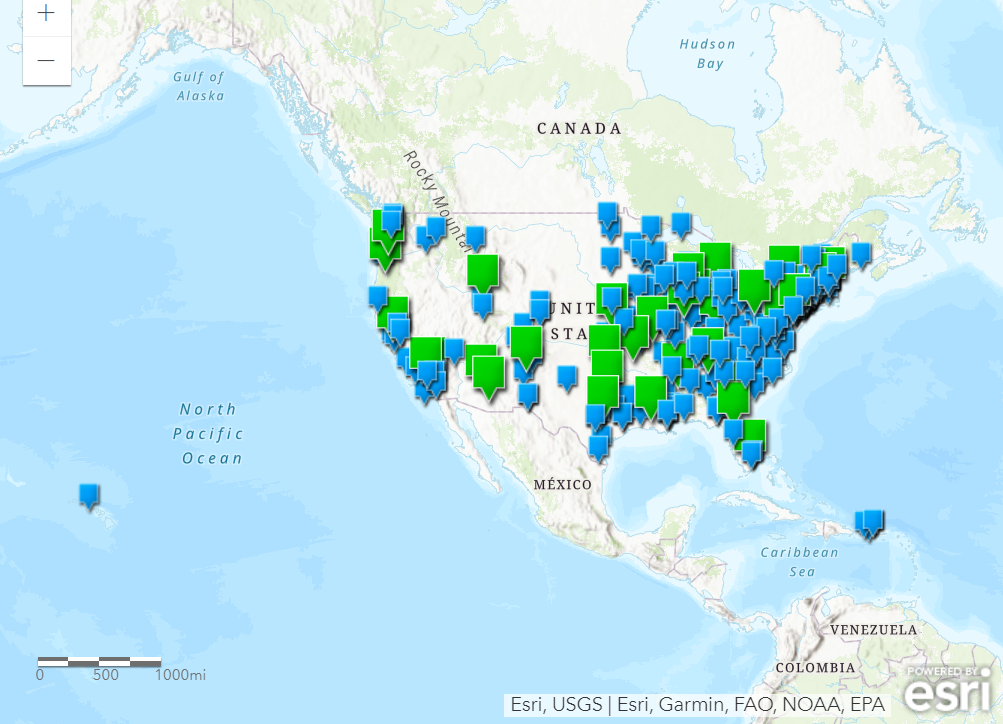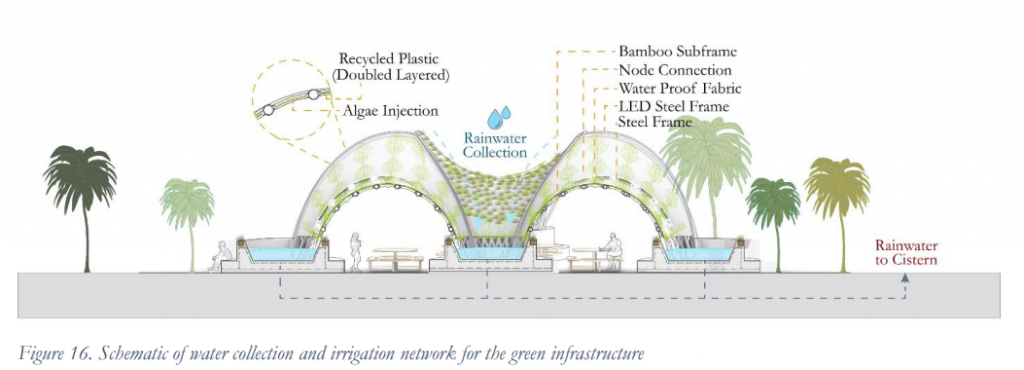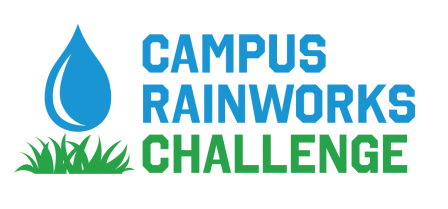In April, the U.S. Environmental Protection Agency (EPA) announced the University of Maryland (UMD; College Park) and Florida International University (FIU; Miami) as first-place winners in this year’s Master Plan and Demonstration Project categories, respectively, in the 10th-annual EPA Campus RainWorks Challenge.
Master Plan Winner: University of Maryland
In the Master Plan category, student teams developed long-term strategies to integrate green infrastructure concepts throughout their entire campuses.
The student team representing UMD described their 27-ha (66-ac) project area in submission materials as “car-centric,” located alongside a major entryway into campus for approximately 15,000 commuting students and home to a busy UMD athletic complex. Approximately one-third of the neighborhood, which straddles two tributaries of the sensitive Anacostia River, is covered in impervious parking lots. Currently, these parking lots are served only by inlets that redirect untreated runoff into the tributaries and, in turn, the Chesapeake Bay.

The winning Master Plan from the UMD team proposes to update and relocate parking for the athletic complex. Additionally, it lays out a 40-year, $300-million USD green infrastructure timeline that aims to reduce the area’s runoff generation rates by more than half and achieve a range of co-benefits.
First, the plan calls for consolidating five existing, surface-level parking lot into a new, multi-tier parking garage. The spaces formerly occupied by parking lots that currently generate motor oil, tire rubber, and other potential runoff pollutants would become new recreational fields, able to accommodate students, athletes, and tailgaters. On rainy days, cisterns beneath the fields would capture up to 28,000 L (7,500 gal) for irrigation and other non-potable uses, the team describes in a video about their proposal. Meanwhile, the new parking garage would feature a green roof and sit next to a “multi-modal transportation plaza,” providing convenient bicycle, scooter, and skateboard rentals as well as access to shuttle buses and other public transportation options.
Recent UMD initiatives to encourage and expand public transportation — including five new light-rail stations currently being built throughout campus — have already caused a notable decrease in on-campus vehicle traffic since 2018 even despite an increase in enrollment, according to data cited by the project team. The plan envisions taking advantage of this trend by restricting non-emergency vehicle traffic to the periphery of campus, replacing most inner roadways with new, permeable walkways geared toward pedestrians and cyclists. Lined by a suite of new bioswales and native trees, the plan calls for 700 m (2,300 ft) of new bicycle lanes.
By 2060, the plan accounts for a new basketball stadium as well as a new academic building elevated above the floodplain by stilts, both equipped with green roofs. It also describes extensive stream revitalization efforts, including a 62% increase in streamside riparian buffer coverage in addition to a new walking trail along Campus Creek. All told, project documents describe that the improvements could enable the site to fully treat a 6-cm (2.5-in.) rain event, mitigating flooding while drastically cutting Anacostia River water pollution. The team notes in their submission that the project’s goals, approaches, and location would make it eligible for a host of local, state, and federal grant programs to help subsidize construction and maintenance costs.
Watch a video about the UMD team’s Master Plan, titled “Future Flows,” on YouTube:
Demonstration Project Winner: Florida International University
Demonstration Project entrants submitted plans for smaller-scale green infrastructure projects that provide innovative solutions to local environmental, social, and economic challenges.
Within the FIU campus in North Miami sits the Marine Academy of Science and Technology (MAST@FIU), a public high school that cooperates directly with FIU to offer its students specialized education in marine and environmental research. The FIU team focused on MAST@FIU for its winning Demonstration Project submission, tailoring green infrastructure interventions according to U.S. National Oceanic and Atmospheric Administration (NOAA) predictions for Miami-area sea-level rise by 2050.
During the Florida coastline’s infamous downpours, rain that falls on the 6-ha (15-ac) MAST@FIU campus is currently collected and diverted into a retention pond that allows it to infiltrate the area’s porous limestone substrate and recharge groundwater supplies. In low-lying Southeast Florida, the project team contends that the existing approach may be unsustainable. According to NOAA data, the level of the sea lining the coast of campus has already risen by at least 15 cm (6 in.) within the last 30 years and is poised to continue at an accelerating rate. As the sea level rises, underground capacity for groundwater aquifers shrinks and could exacerbate flood risks, the team describes in project documents.

Interventions recommended by the team focus on decreasing runoff generation by increasing opportunities for evapotranspiration, a process that began by identifying the specific points on campus most prone to coastal flooding and the effects of sea-level rise. The team first focused on a 400-m (1,300-ft) stretch of the main access road serving both the FIU and MAST@FIU campuses, which modeling showed as particularly susceptible to storm surge compounded by sea level rise. The team found that elevating this stretch of road by just 25 cm (10 in.) would eliminate flood risks from storm surge under a 2050 climate scenario.
For the main MAST@FIU building, the project team designed a 1,850-m2 (20,000-ft2) green roof capable of retaining up to 107 cm (42 in.) of precipitation each year, dramatically slowing runoff generation. Additionally, modeling by the team demonstrates significant benefits for heat mitigation — installing a green roof could cool indoor temperatures at MAST@FIU by as much as 3.5°C (6.3°F). The green roof would join a retrofit for the 2-ha (5-ac) of on-campus parking lots utilizing native vegetation and permeable pavement.
Finally, the team’s proposal calls for a series of uniquely designed “multipurpose smart pavilions” scattered throughout campus. The pavilions would consist of small basins for water collection connected by sharply curved, geodesic shelters inspired by leaves. The shelters, fabricated from steel, concrete, and bamboo, sport a double-layered, bioplastic-based outer shell equipped with injectors capable of spreading micro-algae throughout the shell subsurface. Sustained by sunlight and oxygen, this micro-algae mimics photosynthesis and naturally sequester carbon from the pavilion’s surroundings. The modular pavilions would provide comfortable gathering places for students while also capturing and retaining stormwater.
According to submission documents, the project would cost approximately $3.5 million in capital as well as around $60,000 USD in annual maintenance costs. It would increase stormwater infiltration on the site by 68%, reduce runoff generation by 73%, and reduce total suspended solids loading into Biscayne Bay by 75%.
Watch a video about the FIU team’s Demonstration Project, titled “Resilient MAST@FIU,” on YouTube:
About the Challenge
Student teams represented 35 U.S. colleges and universities across the nation. They devised in-depth plans to bring green infrastructure into their communities.
Technical experts from the Water Environment Federation (WEF; Alexandria, Virginia) provided support for this year’s Campus RainWorks Challenge alongside counterparts from the American Society of Civil Engineers (Reston, Virginia) and American Society of Landscape Architects (Washington, D.C.).
“Green infrastructure is essential to building dynamic and thriving communities,” said Radhika Fox, EPA Assistant Administrator for Water, in a release announcing the winners. “When we apply green infrastructure strategies — like those exemplified by the Campus RainWorks winners — projects can meet community needs while supporting clean water goals.”
Top image courtesy of U.S. Environmental Protection Agency

ABOUT THE AUTHOR
Justin Jacques is editor of Stormwater Report and a staff member of the Water Environment Federation (WEF). In addition to writing for WEF’s online publications, he also contributes to Water Environment & Technology magazine. Contact him at jjacques@wef.org.




